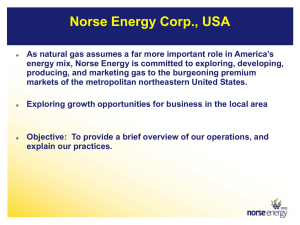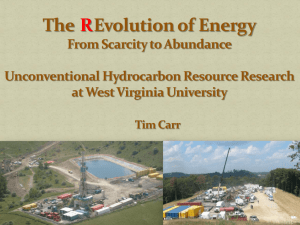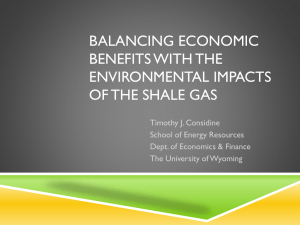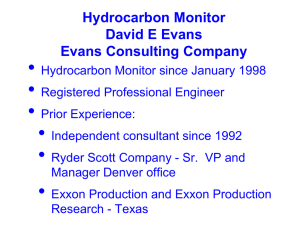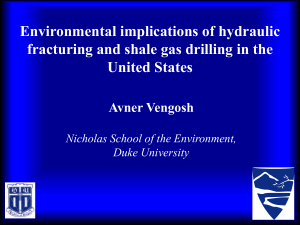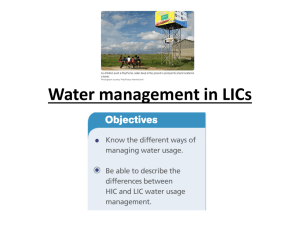PPT
advertisement
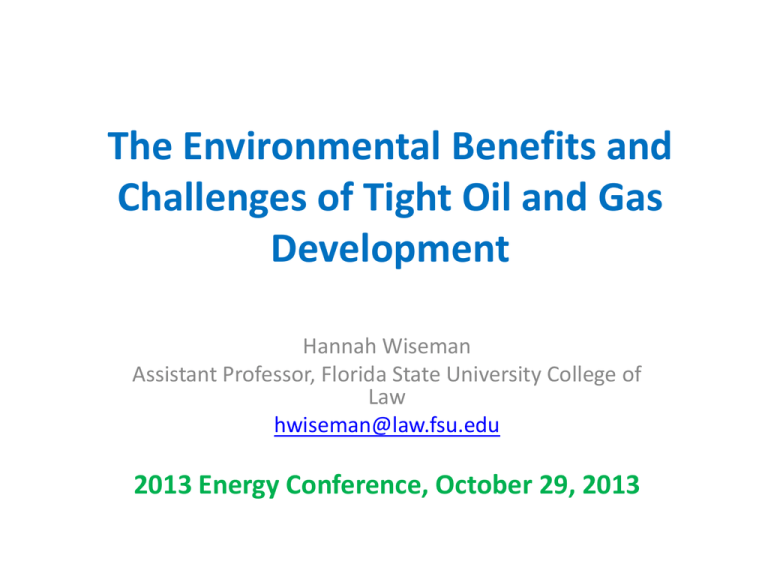
The Environmental Benefits and Challenges of Tight Oil and Gas Development Hannah Wiseman Assistant Professor, Florida State University College of Law hwiseman@law.fsu.edu 2013 Energy Conference, October 29, 2013 The development of oil and natural gas resources from shales and tight sandstones— “tight” formations—has transformed domestic fossil fuel production, causing the United States to become a leading producer. What are the environmental benefits and challenges of this transformation, and what opportunities for improvement remain? http://marcellus.psu.edu/resources/PDFs/marcellusshalereport09.pdf.pdf Road map of presentation • National perspective on benefits and costs: simultaneous displacement of coal and renewables/energy efficiency. • Wellhead perspective: smaller surface footprint due to horizontal drilling, but tens of thousands of new wells and associated impacts. • The regulatory landscape, with a focus on the states, and improvements needed. National benefits: displacement of coal in electricity generation Lower U.S. CO2 emissions Methane leakage: the latest science • “Magic number” for climate is 3.2% leakage or lower (Environmental Defense Fund estimate). • Allen et al. (2013): methane leakage during flowback is low—0.42% of gross gas production. – Measured actual leakage from 489 hydraulically fractured wells (27 flowbacks). Although controlled for potential bias, might have measured best practices. • Alvarez et al. (2012): converting fleets to CNG “increases radiative forcing for 80 yr. before any net climate benefits are achieved.” National costs: displacement of other innovative efforts, renewable technologies Henry Jacoby et al. (MIT), The Influence of Shale Gas on U.S. Energy and Environmental Policy (2012): • “The gas ‘revolution’ has important implications for the direction and intensity of national efforts to develop and deploy low-emission technologies, like CCS [carbon capture and storage or sequestration] for coal and gas.” It will slow and in some cases stop these efforts. • Cheaper gas “serves to reduce the rate of market penetration of renewable generation.” Energy Information Administration: Estimated levelized cost of new generation resources, 2018, in 2011 dollars per megawatt hour, excluding tax credits Plant type Levelized capital cost Fixed O&M Variable O&M (including fuel) Transmission Total system investment levelized cost Conventional 65.7 coal 4.1 29.2 1.2 100.1 Conventional 15.8 combinedcycle gas 1.7 48.4 1.2 67.1 Advanced nuclear 83.4 11.6 12.3 1.1 108.4 Wind onshore 70.3 13.1 0.0 3.2 86.6 Geothermal 76.2 12.0 0.0 1.4 89.6 Solar PV 130.4 9.9 0.0 4.0 144.3 Solar thermal 214.2 41.4 0.0 5.9 261.5 Hydro 4.1 6.1 2.0 90.3 78.1 Wellhead perspective: environmental risks Potential risks in this presentation identified from the following materials: – Violations of state environmental and oil and gas laws at wellheads. – Other incidents collected and reported by state or regional agencies and courts. – Peer-reviewed papers. http://www.dec.ny.gov/docs/materials_minerals_pdf/rdsgeisch6b0911.pdf Most important risks (it appears) • Cumulative impacts – Traditional risks (long known in oil and gas industry), magnified due to number of wells: landscape impacts, habitat fragmentation, air emissions, other risks • Spills and leaks from pits and tanks: contamination of soil, surface water, groundwater • Bird deaths in pits (but low as compared to deaths caused by house cats and automobiles) https://www.fws.gov/phdec2012.html • Impacts on streams when water withdrawn simultaneously within one region • Inadequate casing and plugging of wells • A lack of good options for disposal: large quantities of liquids; solids that settle out of brine and flowback • Road damage and other local challenges http://gallery.usgs.gov/photos/03_08_2013_v0Qd72Gts4_03_ 08_2013_7 Other risks: not as prevalent (perhaps), but single incidents can have large impacts Leaking underground injection control (UIC) disposal wells Induced seismicity from UIC wells http://water.epa.gov/type/groundwater/uic/class2/ Cumulative impacts • The EPA estimates that 11,400 new wells are fractured or refractured annually in the United States. • In New York State, 56,508 horizontal gas wells and 6,723 vertical gas wells could be drilled and fractured in thirty years (NY Dept. of Envtl. Conservation). • Approximately 28,000 wells will have been drilled in Texas’s Barnett Shale by 2030. (Currently at 16,000 wells.) City of Fort Worth, Texas: 1,856 producing wells http://fortworthtexas.gov/gaswells/defau lt.aspx?id=50608 Cumulative air emissions Air impacts http://www.ndoil.org/image/cache/NDPCAnnual092111_2.pdf Colorado Gabrielle Petron et al., Hydrocarbon Emissions Characterization in the Colorado Front Range: A Pilot Study, J. Geophysical Research (2012) Analysis of daily air samples “since 2007 shows highly correlated alkane enhancements caused by a regionally distributed mix of sources in the Denver-Julesburg Basin.” Attributed to “a mix of venting emissions (leaks) of raw natural gas and flashing emissions from condensate storage tanks.” Spills Pennsylvania Marcellus: Two fuel tank trucks collided at the pad entrance. . . . The fuel tank was damaged and leaked approximately 15 gallons of diesel fuel” onto road. Contaminated material excavated. Permit 115-20293. Self-reported 20-gallon diesel spill from delivery truck. Permit 115-20298. New Mexico tight sands: “A fuel pump split, allowing 1,000 gallons of diesel to be released. 100 gallons recovered.” API 30-039-30557. Louisiana Haynesville: “Oil based mud discharged in vicinity of well and allowed to migrate to natural drainage.” Permit 239818. Pennsylvania Marcellus: “1,500 gallon spill of drilling mud . . . observed on the surface of the ground outside of the containment area.” Permit 131-20047. New Mexico tight sands: “During fracking a valve was left open due to human error causing a release of 245 gallons of frac water, all recovered.” API 30-045-34625. Pennsylvania Marcellus: “Blowout, frac fluid release” in Tioga County. Permit 117-20373. Surface pits and tanks Louisiana Haynesville: Frac tanks used for temporary storage of produced saltwater. Gauging error caused overflow, and water flowed into ditch and swampy area. Permit 238585. Texas Barnett shale: Driveway, pasture, pond polluted with low chloride drilling fluids diluted with rain water. Permit 630921. Colorado tight sands: “Excessive oil accumulation at tank battery. Berm not sufficient at tank battery. Excessive oil on ground at wellhead, oil is migrating down grade (from wellhead) toward upper pit. Wildlife accessing both pits.” API 05-103 -08459. U.S. v. Brigham Oil and Gas (D.N.D. 2012)—Bakken Shale reserve pits “On May 6, 2011, Special Agent Grosz and [Fish and Wildlife] Service Contaminants Specialist . . . .inspected the . . . site. Grosz inspected the pit and noted it was not netted or flagged at the time of inspection. He noticed an oil sheen “on the fluid of the reserve pit.” During the inspection, . . . Grosz observed and collected “two dead and oiled mallards.” Dead pintails and ring-tailed ducks also found. http://dwrcdc.nr.utah.gov/rsgis2/search/Display.asp?FlNm=anasacut Simultaneous water withdrawals Susquehanna River Basin Commission, July 16, 2012, 64 Water Withdrawals for Natural Gas Drilling and Other Uses Suspended to Protect Streams “Under SRBC’s passby flow restrictions, when streams drop to predetermined protected low flow levels, operators who are required to meet the agency’s passby requirement must stop taking water.” Most states and regions do not have this type of regulation. http://www.srbc.net/newsroom/NewsReleasePrintFriendly.aspx?NewsReleaseID=90 Inadequate casing and plugging of wells Pennsylvania Marcellus: “Methane migrated to surface through cement in 9 5/8” annulus.” Permit 033-26848. (Post-drilling – well shut in): “Cellar is filled with water. . . .Well head is leaking from somewhere below the surface of the water. Gas is bubbling up through the water all around the wellhead.” Permit 033-26828. “March 30, 2011 order: “Catalyst Energy’s unpermitted discharge of iron, manganese, dissolved methane, dissolved ethane, and combustible free gas from its drilling activities into groundwater violates . . . the Clean Streams Law . . . [and] constitutes unlawful conduct and a public nuisance.” Mar. 10, 2009 letter from DEP, Bradford, PA: Lab analysis of spring water “indicated levels of Chlorides, Total Dissolved Solids, Calcium, Sodium and Specific Conductivity that were in excess of EPA’s drinking water standards. Elevated levels of these parameters are indicative of a dilute brine solution and suggest an infiltration of frac water into the shallow ground water that supplies your spring.” Disposal challenges Lara A. Haluszczak et al., Geochemical Evaluation of Flowback Brine from Marcellus Gas Wells in Pennsylvania, APPL. GEOCHEM. at 6 (2012) noted levels of radium in flowback water “13-1300 times that maximum contamination level for drinking water standards.” Difficult to treat at a wastewater treatment plant. Underground injection control wells Oklahoma Geological Survey (2011) “Cases of clear anthropogenically-triggered seismicity from fluid injection are well documented with correlations between the number of earthquakes in an area and injection.” See also Katie M. Keranen et al., Potentially Induced Earthquakes in Oklahoma, USA: Links Between Wastewater Injection and the 2011 Mw 5.7 Earthquake Sequence, GEOLOGY (2013). Midland, Texas: an improperly constructed injection well—maintained by a company now in bankruptcy—leaked into the city’s drinking water aquifer, creating a “‘plume’ of chloride infested water that is (and has been for some time) migrating through the Aquifer” and progressively polluting more fresh water. Approximately 6.2 billion gallons had been contaminated by 2010. Road damage and other local challenges National Park Service estimates average well requires 320 to 1,365 truck trips, depending on whether water is trucked in or piped in. http://marcellus.psu.edu/resources/PDFs/m arcellusshalereport09.pdf.pdf http://www.willistondevelo pment.com/usrimages/Willi ston_Impact_Statement.pdf The regulatory landscape REGIONAL LOCAL States determine nature and extent of local jurisdiction. STATE States have independent authority over many development activities. PUBLIC-PRIVATE States work with nonprofits and industry groups to write guidelines, review regulations. States, with federal approval, participate in compacts. FEDERAL States implement certain federal environmental regulations. State regulations • For cumulative impacts, not much regulation, although Colorado leads in controlling air emissions, and Maryland has proposed a comprehensive gas drilling plan. • Spills; leaks from pits and tanks: well and well site setbacks, minimum pit liner thickness, minimum “freeboard” in pits. Pits must be dewatered and filled in. Well setback requirements Pennsylvania Act 13, effective Apr. 16, 2012 – under review Regulatory provision Before Apr. 16, 2012 As of Apr. 16, 2012 Distance between gas well and water well 200 ft. 58 Pa. C.S. § 601.205 500 ft. 58 Pa. C.S. § 3215 Distance between well site or 100 ft. well and stream 58 Pa. C.S. § 601.205 300 ft. 58 Pa. C.S. § 3215 Distance between well pad and public water supply 1,000 ft. 58 Pa. C.S. § 3215 no regulation identified Rebuttable presumption that 1,000 ft. for contamination oil and gas operations caused within 6 months of water contamination operations 58 Pa. C.S. § 601.208 2,500 ft. for contamination within 1 year of operations 58 Pa. C.S. § 3218 West Virginia Natural Gas Horizontal Well Control Act, HB 401, effective December 14, 2011 Regulatory provision Before December 14, 2011 As of December 14, 2011 Distance between gas well and water well 200 ft. W. Va. Code § 22-6-21 250 ft. W.Va. Code § 22-6A-12 Distance between well pad or well and stream no regulation identified 100 ft. W. Va. Code § 22-6A-12 Distance between well pad or well and trout stream no regulation identified 300 ft. W. Va. Code § 22-6A-12 Distance between well pad and public water supply no regulation identified 1,000 ft. W. Va. Code § 22-6A-12 Rebuttable presumption that w/in 1,000 ft. of site oil and gas operations caused water contamination W. Va. Code § 22-6-35 w/in 1,500 ft. of site W. Va. Code § 22-6A-18 • Few direct regulations to protect against bird deaths, although some states require netting or pit covers. • Stream impacts from cumulative water withdrawals: states like West Virginia and Pennsylvania require operators to show that water withdrawal will not harm aquatic life. Federal listing of diamond darter as endangered will likely affect water use in Marcellus. http://conservationfisheries.org/index.php/species/currentspecies/crystallaria-cincotta-diamond-darter/ Casing and well plugging: few states have updated well bonding requirements, but many mandate pressure tests of wells prior to fracturing. Some have increased required casing depths, and some limit the installation of used casing. Most states provide minimum times for which cement must set before being disturbed, and many specify the type of cement that must be used. http://www.rff.org/centers/energy_economics_and_policy/Pages/Shale_Maps.aspx #maps Casing requirements example – Ohio SB 165, effective June 30, 2010 Before June 30, 2010 As of June 30, 2010 “[G]ood and sufficient wrought iron or steel casing so as to exclude all surface, fresh, or salt water from any part of such well.” “[S]ufficient steel or conductor casing” that protects unconsolidated sediments and water. Method of placing casing approved by Chief of Division of Mineral Resources Management. Materials must “comply with industry standards for the type and depth of the well and the anticipated fluid pressures that are associated with the well.” Sour gas and gas bearing zones must be isolated. In lieu of casing, Chief could accept “adequate mudding methods.” Oh. St. § 1509.17 Well shall not be perforated in zones of water protection. Well owner shall notify mineral resources inspector each time the owner or representative notifies someone to perform casing. Oh. St. 1509. § 17 Tracking water quality Baseline testing: not uniform, but states increasingly require it: incentivized to 1,500 feet in West Virginia, 2,500 feet in Pennsylvania; required to 1,500 feet in Ohio. See also Colorado and Michigan. State approaches to disposal • Limit the available methods of disposal. – Ohio S.B. 165 (codified at Ohio Rev. Code § 1509.226(10)): “flowback from the stimulation of a well, and other fluids used to treat a well shall not be spread on a road.” • Require treatment prior to disposal. – By 2014, Clean Water Act Treatment Standards for Wastewater from Shale Gas Extraction – 25 Pa. Code § 95.10: operators must reduce total dissolved solids to a certain concentration prior to disposal. • Modify existing wastewater treatment permits. Recycling of flowback and produced water • Very common in the Marcellus Shale region because of 25 Pa. Code § 95.10: wastewater source reduction strategy must “identify procedures” the operator will follow to maximize recycling and reuse. • Not much treatment of water necessary prior to reuse. • Less common in other shales. http://www.ohiodnr.com/Port als/11/pdf/wastewater-factsheet.pdf Changing governance to address community impacts • Pennsylvania Act 13 (2012): impact fee that is redistributed for environmental remediation, conservation, roads and bridges, low-income housing. – Pennsylvania Supreme Court still attempting to determine constitutionality of Act 2013 after a Commonwealth court struck down the Act. • Road use agreements and other community benefits agreements. • Zoning to limit areas in which well development may occur (where not preempted); cap decibel levels; require sound barriers and fences. Gina Banai, Rice Energy Also note the importance of private standards • Lenders and lessors increasingly require environmental protections within contracts and leases, such as lining of the entire well pad, no drilling in areas with too much surface water. • Companies increasingly voluntarily disclose chemicals added to fracturing water on FracFocus, but we still do not know the composition of much of the flowback water, which contains naturally occurring substances. • API standards, standards from Center for Sustainable Shale Development impact certain operators’ behavior. State regulation: the enforcement challenge CO 2012 MI 2012 NM 2012 OH 2012 PA 2010 TX 2012 Number of field inspectors 36 27 12 40 76 153 Approximate number of active oil and gas wells (conventional and unconventional) 49,062 (approx. 87 in field) 15,742 56,366 55,083 92,326 See Regulatory Risks in Tight Oil and Gas Development. Hannah Wiseman. Natural Gas & Electricity 29/5, ©2000, Wiley Periodicals, Inc., a Wiley company, for sources. 279,856 Actual inspections and enforcement State and year Approximate Number of number of inspectors active oil and gas wells Inspections conducted Violations noted Enforcement actions taken Pennsylvania 92,326 2012 76 26,913 3,378 949 Texas 2009 87 128,000 80,000 550 280,000 http://www.portal.state.pa.us/portal/server.pt/community/oil_and_gas_compliance_report/20 299; http://www.sunset.state.tx.us/82ndreports/rct/rct_fr.pdf Regulatory improvements needed Comprehensive analysis of variability among state regulations should be a top priority. • In some cases, geology, climate, and other factors may justify differences. • In other cases, there might be one, accepted practice for adequately protecting against risk, yet this practice is not consistently required. States should consider regulations with “total harm thresholds” – those that address cumulative impacts. – Susquehanna River Basin Commission regulations require water withdrawals to cease if streams drop below a protected low flow level. Bond amounts should be updated • Indiana: $2,500 per oil and gas well, plus annual fee, Ind. Code 14-37-6-1 • Ohio: $5,000 per well, Ind. Code 14-37-6-1 • Arlington, Texas $50,000 per well, City of Arlington, Tex. Ordinance No. 07-074 § 6.01(B)(1)(c) More insurance requirements possibly needed • Ohio Substitute Senate Bill No. 315 requires liability insurance “of not less than five million dollars bodily injury coverage and property damage coverage,” and a “reasonable level of coverage available for an environmental endorsement.” Codified at Ohio Rev. Code § 1509.07. • Few states require environmental liability insurance. But see Maryland S.B. 854 (approved May 16, 2013). Better enforcement needed • States likely need to raise well permitting fees to fund more inspection staff. • Through training, states should alert industry to new rules to enhance compliance. • States should establish enforcement priorities. (Pennsylvania—incidents that “result in an actual release of gas or pollutants and endanger human life or public health and safety”). Example of industry training Governments should reassess who has what authority and why • States are not in all cases the best entities to regulate oil and gas development. • Municipalities still need some control if high drilling and fracturing rates are to continue— minimal zoning and nuisance-prevention authority needed. • Federal government should, at minimum, more closely investigate inconsistencies among state regulations and consider filling gaps if states do not. Substantive gaps to prioritize • Pit and tank management, including pits that hold flowback for reuse, and secondary containment requirements • Wastewater reuse and disposal • Baseline and post-drill water testing • Casing requirements, including well pressure tests--must ensure that casing can withstand pressure of fracturing, and not all states do • Water withdrawal regulations • Community impacts Summary of points • Upstream oil and gas, like many other industries, poses a number of risks. We can limit many of these risks; others are more difficult to address. • Governments are rapidly updating certain regulations, but gaps remain. • Enforcement should be the first gap filled: states should raise fees so that they can hire more staff, set and implement priorities. Consider electronic monitoring at sites? Thank you. I welcome questions and comments: hwiseman@law.fsu.edu.




